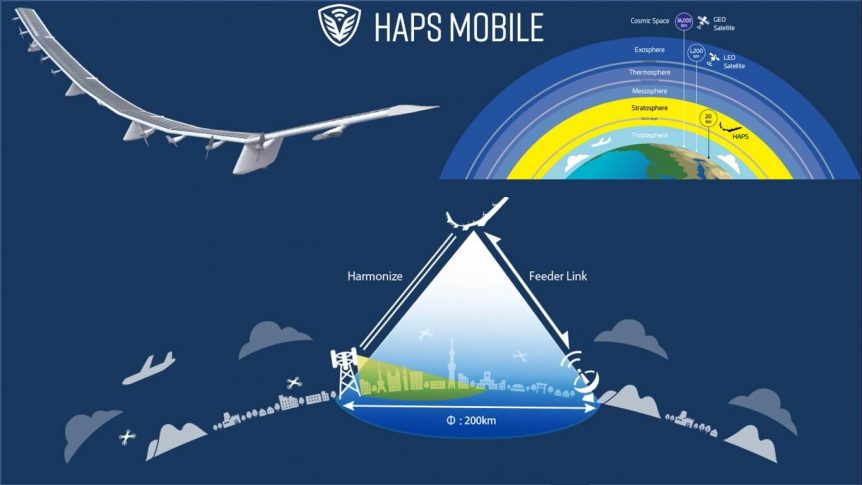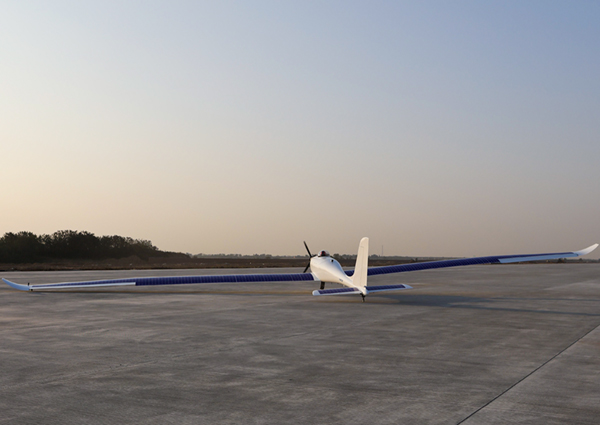What do a Japanese investment bank, a software network, balloons and a gigantic stratospheric flying wing called HAPS have in common? Let’s look at the players and then piece together this puzzle. Softbank According to Wikipedia, “SoftBank Group Corp.[11][12] is a Japanese multinational conglomerate holding company headquartered in Minato, Tokyo. SoftBank owns stakes in many technology, energy, and financial companies. It also runs Vision Fund, the world’s largest technology-focused venture capital fund, with over $100 billion in capital.[13][14] “The company is known for its leadership by founder Masayoshi Son.[15] It operates in broadband, fixed-line telecommunications, e-commerce, internet, technology services, finance, media and marketing, semiconductor design, and other areas. “SoftBank was ranked in the Forbes Global 2000 list as the 36th largest public company in the world,[16] and the second largest publicly traded company in Japan after Toyota.” SoftBank’s web site promotes the “Information Revolution” as “Happiness for everyone.” The bank explains, “Since our founding, the SoftBank Group has sought to promote the Information Revolution to contribute to the wellbeing of people and society.” The Group …
Elektra Solar Launches HALE with Autonomous Control
Dr. Birgit Weißenbach of Elektra Solar GmbH and PC-Aero announced “The world’s strongest multifunctional solar-electric HALE aerial vehicle – the Elektra Two Solar: [with] “Take-off, flight and tough-down” successfully completed with [its] own autopilot system We usually think of HALE (High Altitude Long Endurance) aircraft as being huge, sun-eclipsing things like AeroVironment’s flying wings or Boeing’s Phantom Eye. These require large support systems and ground crews, much like the team that chased Solar Impulse around the world. Elektra Solar GmbH, a joint venture combining PC-Aero GmbH and Elektra UAS GmbH, uses aircraft designed by Calin Gologen, head of PC-Aero, and computer technology from Dr. Ing. Habil. Konstantin Kondak. Since October, 2009 he headed a key research area, Flying Robots at DLR’s Institute of Robotics and Mechatronics in Oberpfaffenhofen near Munich. Their collaboration led to two svelte HALEs, the smaller Elektra One Solar (a veteran of a solar-powered Alpine crossing) and the larger Elektra Two Solar. This airplane is also the …
Sustainable Skies in San Francisco
I’m writing this in the first person, rather than the usual third-person voice that allows me to remain objective about things on which I report. In this case, I have been the recipient of much joy over the last ten years from being an observer of the ongoing progress in electric aviation. Dr. Brien Seeley, founder of the Sustainable Aviation Foundation, asked me to begin writing a blog about electric aviation in 2009. One of my original postings concerned a Kitplanes Magazine contributor, David Ullman – who was this year’s Sustainable Aviation Symposium’s keynote speaker. In 2009, he predicted a great future for electric aviation – most of which has come to pass, and some of which he is creating in his hangar with his fully-instrumented wind tunnel and ambitious blown-wing design. He proposes something called USTOL, Ultimate Short Takeoff and Landing, aircraft that will use a dynamic relationship between their power and lift systems. His vehicle for demonstrating this …
Boeing Adds Solar Winglets to Its Solar High-Flyer
Despite having a wing, horizontal tail, and fuselage top full of solar cells, Solar Impulse 2 needs long days and short nights to make it through the dark periods between recharging. Even Eric and Irena Raymond’s SunSeeker Duo, a more practical machine, performs only day-long flights so far. Part of this is the nature of sunlight and solar cells, both of which are limited in small areas. Despite the fact that every hour, each square meter of the upper atmosphere receives 1.367kWh of solar energy, and National Geographic claims that “Every hour the sun beams onto Earth more than enough energy to satisfy global energy needs for an entire year,” it’s hard to harness that energy on a relatively small surface area. Solar cells at their best convert only a small percentage of the energy beamed onto them into usable current. On Solar Impulse 1, this was about 22.7 percent, according to Sunpower, the cell’s maker. Newer cells are reported …
Hydrogen: Are We There Yet?
Probably not, but we are edging closer to when H2-powered vehicles (including small aircraft) might be as ubiquitous as Prius’s or Leafs – but there are significant barriers to overcome. Fuel cell-powered aircraft might make sense eventually from a physical and economic sense, and while new technologies show promise for EV use, hydrogen power still has barriers to overcome before we’re able to exploit the environmental benefits of hydrogen power. The appeal of a fuel cell to burn hydrogen and leave behind only a light mist of water still dazzles, but teasingly eludes us, not so much from a technical standpoint – but from environmental and economic ones. Two Most Practical Fuel Cells for Transportation Fuel cells come in many varieties, with proton exchange membrane (PEM) and solid oxide fuel cells (SOFC) types heading the list for practical vehicle use. PEM cells, according to Fuelcell.org, “operate at relatively low temperatures, have high power density, and can vary output quickly to …
Fastest Electric Vehicle Design at EAS VI
Dr. Brien Seeley, President of the CAFE Foundation, has made the following announcement: “The Chief designer of the F-22 Raptor has prepared another spectacular design: The World’s Fastest Electric Vehicle. This new aircraft design will be presented along with the other outstanding talks at next week’s CAFE Electric Aircraft Symposium, April 27, 28 in Santa Rosa, California (Sonoma Wine Country). This symposium, dedicated to the burgeoning new domain of emission-free flight, now has representatives from Boeing, Bosch, IBM, Honda, Nortrhop-Grumman, Japan Air Lines, Rolls-Royce, Siemens, Aerovironment, FAA, Cummins, Cessna, Lycoming and many other companies enrolled to participate.” The high-speed electric may be a response to Ivo Boscarol’s pledge to put up $100,000 of his Pipistrel G-4 winnings at last year’s Green Flight Challenge for the first supersonic electric aircraft. Program Details can be found here. There is still time to pre-register online here.
Albatross, Dragonflies, and Hummingbirds
Your editor took a trip to Tehachapi, once home of the infamous California Women’s’ Correctional Institution, mentioned in no less than three 1940’s films noirs. (It’s now a gray-bar hotel for bad boys, not bad girls.) Lesser offenses were in mind, though, since Labor Day weekend has been the time for 31 meetings of the Experimental Soaring Association’s Western Workshop. The group, devoted to improving sailplanes and testing the limits of soaring technology, has been in the forefront of many significant developments, and its members include many record holders and aerodynamics experts. This year’s convocation included talks on birds, dragonflies (the Libelle sailplane), and even a demonstration of Aerovironment’s spy hummingbird, a camera-toting drone no larger than a 90-percentile member of the Trochilidae family. Phil Barnes kicked off the Saturday talks, showing his incredible computer simulations of the dynamic soaring flight of the Albatross, which included an impassioned plea to help preserve this magnificent bird. He noted that “gyres” of plastic slurry distributed …
“Mishap” to AeroVironment Global Observer
It wasn’t an April Fool’s Day joke, even though AeroVironment’s press release is dated April 1. Their Global Observer crashed in the Mojave Desert during extended duration flight testing. AeroVironment stressed that there were “No injuries or damage to other property reported during envelope expansion flight testing,” and that an “Investigation Board will be convened to probe the cause and provide details of the mishap.” The mishap occurred at 2:30 a. m., approximately 18 hours into the craft’s ninth test flight. AeroVironment’s press release continues, “’Flight testing an innovative new solution like Global Observer involves pushing the frontiers of technology and convention,’ said Tim Conver, AeroVironment chairman and chief executive officer. ‘Risk is a component of every flight test program, and the learning that results from a mishap enables us to improve system reliability and performance. One benefit of testing an unmanned aircraft system is that pilots and crew are not in harm’s way when a mishap occurs.’” The flight test team, …
Something(s) Amazingly New Under the Sun
To share an idea of how packed with information and inspiration an Electric Aircraft Symposium can be, I’m still writing reports on the fourth annual event, even though EAS V is coming up April 29 in Santa Rosa, California. This is the next-to-last blog entry on last year’s presentations, and as noted in yesterday’s press release for the event, 2011’s will have at least as many presenters and material. Tyler MacCready is the son of Paul MacCready, founder of AeroVironment, Inc. and inspiration for many human-powered, ultralight, and solar-powered aircraft over the last several decades. This author was in England when Bryan Allen pedaled Gossamer Albatross across the English Channel, a breakthrough in what was considered aerodynamically and structurally possible. At age 14, Tyler had been the test pilot for the Albatross. Such experiences led to his early work in solar-powered aircraft, as he told attendees at the fourth annual Electric Aircraft Symposium. Tyler was there as part of AeroVironment’s …
Boeing’s PhantomEye Powers Up
While AeroVironment’s Global Observer High Altitude Long Endurance aircraft has flown at the NASA Dryden Flight Test Center, Boeing’s PhantomEye HALE is in pieces but undergoing testing prior to being shipped to Dryden. PhantomEye’s hydrogen-fueled engines are being tested at Santa Clarita, California and airframe parts are being prepared for flight at Boeing’s St. Louis, Missouri plant. AeroVironment’s craft has now flown with fuel cells providing electricity to run the four wing-mounted motors. PhantomEye uses hydrogen stored in eight-foot diameter tanks in its fuselage to directly fuel the twin Ford 2.3-liter modified engines. At altitude, a three-stage turbocharger will be required to provide air for an efficient fuel burn. Both unmanned aerial vehicles have similar missions, to fly at 65,000 feet for up to a week at a time while providing surveillance, monitoring, and communication for military and civilian applications.
- Page 1 of 2
- 1
- 2



